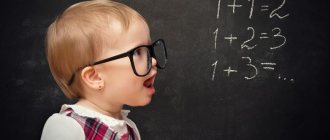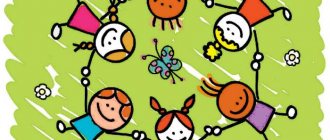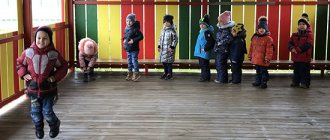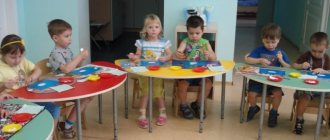The article presents general recommendations and time-tested practical advice on how to develop thinking in a child.
Thinking reflects a person’s ability to understand the world around him, think, accumulate knowledge, discover new laws, solve emerging problems and tasks, create and transform.
The foundation of thinking is laid in early childhood, when the child first masters visual-actional thinking (it is basic until about 5 years old), then visual-figurative thinking (it prevails until about 6-6.5 years old) and verbal-logical thinking (it is formed around the age of 6-6.5 years). 6 years old, predominates from 7-8 years old and remains dominant in most adults). Visual and effective thinking allows a child to explore the world through interaction with objects.
Visual-figurative thinking makes it possible to imagine objects, even if they are not available, and operates with these images and ideas (remember how Malvina asked Pinocchio to imagine that he had an apple in his pocket?). You can read more about the development of visual thinking on our blog, in the article “Development of Visual Thinking”.
Verbal-logical thinking allows the child to handle words that denote phenomena or objects. It grows out of the figurative and helps to analyze and synthesize, reason, draw conclusions, classify, infer, compare, highlight the main and secondary.
Logical thinking in preschool children goes through some stages of development:
- Mastering the ability to compare, generalize, divide into groups, and classify.
- Modeling.
- Ability to work with algorithms and create algorithms.
- Combinatorics.
- Solving problems on intelligence and the rudiments of using scientific information.
- Clarification of the meaning inherent in fairy tales, proverbs, riddles.
- Solving puzzles, watercress crosses.
Peculiarities of thinking in preschoolers
A child’s thinking in the preschool period develops in conditions of rapid maturation and is determined by a number of accompanying factors, the main of which are:
- Expanding your social circle. If during early childhood the child had contact only with his parents, then in preschool age he begins to communicate with his peers and teachers.
- Speech development. The child learns not only to understand, but also to pronounce words correctly and construct phrases correctly.
- Formation of an analytical worldview. During the preschool period of growth, the perception of shapes, colors, sizes, space and time improves.
- Acquiring new skills and abilities. The child learns to read syllables, recite poetry, sing, and draw.
- Formation of personal qualities. During educational activities and communication with other children, strong-willed character traits are developed, such as organization, perseverance, and initiative.
- Formation of self-esteem. The preschooler develops awareness of his “I” and develops a critical assessment of himself.
- Exhibiting self-control. The child learns to manage his actions, behavior, and activities.
The thinking of a preschooler begins to form on the basis of practical experience, when the child strives to touch, disassemble, and break the objects around him.
As children grow older, a figurative perception of reality appears, which becomes the main form of children's thinking in the preschool period. Tactile cognition remains, but takes on more advanced forms.
At the end of the preschool period, the child’s cognitive activity is enriched with elements of logic. This indicates the preschooler’s readiness to develop logical knowledge.
Logic problems
Perhaps solving logical and non-standard problems is the most effective way to develop logic and thinking.
For preschoolers and first-graders, logic problems should be clear and well illustrated. Many interesting tasks can be found in one of my books.
More examples of interesting non-standard problems for younger students:
Problem 1 Vasya found 36 more mushrooms than Lena. On the way home, my sister began to ask Vasya: “Give me a few mushrooms so that I can have as many mushrooms as you!” How many mushrooms should the brother give to Lena?
Task 2 Geese and piglets are walking in the barnyard. Petya counted the number of heads, there were 30, then he counted how many legs there were, there were 84. How many geese and how many piglets were there in the barnyard?
Task 3 Donkeys were grazing in the clearing. Several boys approached them. “Let’s sit on the donkeys one at a time,” suggested the elder. There weren't enough donkeys for the two boys. “Let’s try to sit down two by two,” the elder suggested again. Then one donkey was left without a rider. How many donkeys and how many boys were there in the clearing?
Task 4 How old is Vanya? When Vanya was asked how old he was, he thought and said: “I’m three times younger than dad, but three times older than Seryozha.” Then little Seryozha ran up and said that his dad was 40 years older than him. How old is Vanya?
Problem 5 “Ancient problem”.
Petya needs seven kopecks to buy a portion of ice cream, and Masha needs one kopeck. Then they added up all the money they had. But they were also not enough to buy even one portion. How much did a serving of ice cream cost?
Task 6 The teacher assigned a difficult task in class. As a result, the number of boys who solved this problem turned out to be equal to the number of girls who did not solve it. Who is more in the class: those who solved the problem or the girls?
By solving logical problems, the child will learn to recognize objects by given characteristics, generalize, compare, and identify patterns.
Solving non-standard problems also develops the child’s thinking, attention, and logic.
But not all children are able to solve logical problems. This needs to be learned. Knowing how this or that type of problem is solved, the child can easily cope with the task.
O. Naumova “Learning to solve logical problems”
The book examines simple ways to solve logical problems with step-by-step explanations. There are answers to all problems.
These types of problems are often found at school, not only at mathematics olympiads, but also as additional tasks on tests. Therefore, the ability to solve such logical problems will help the child receive a useful positive assessment.
You can start learning from the book as early as preschool age. The tasks are designed colorfully and interestingly.
Classes in this manual will contribute to the child’s development of:
- logic;
- attention;
- thinking;
- intelligence;
- spatial thinking;
- ability to work with tables;
- mathematical abilities;
- memory, etc.
Recommended age 5-10 years. The book can be used for individual or group lessons.
Exercises for the development of interhemispheric connections also give good results. Use different methods. Logical thinking can and should be developed and trained in different ways. Everything is individual. But a focused effort aimed at developing logic will definitely yield good results. Good luck!
Stages of thinking development
As a child grows up, 3 types of thinking are alternately formed:
- objective-effective;
- visual-figurative;
- verbal-logical.
Stages of development of thinking in a preschooler
| Preschool period | Thinking | a brief description of |
| Junior (3-4 years) | Subject-effective | Understanding an object through practical actions: feeling an object, separating and connecting parts, breaking toys. |
| Intermediate (4-6 years) | Subject-effective (develops); visual-figurative (formed) | Studying an object through visual perception, both with and without practical actions. Increasing memory capacity, developing attention and imagination. Ability to use pictorial diagrams to solve simple problems. |
| Senior (6-7 years old) | Visual-figurative (develops); verbal-logical (formed) | Attempts to systematize ideas about an object. Formation of concepts. Establishing cause-and-effect relationships. Ability to reason and solve more complex problems. |
Possible violations
Sometimes parents and teachers are faced with learning problems among preschoolers. Main violations:
- attention deficit;
- difficulties in mastering the material;
- bad memory.
These negative features are associated with deviations of a neuropsychic nature and are observed against the background of an unstable emotional state, behavioral disorders, and neurological disorders.
Thinking disorders in children are associated with problems with speech development. Deviations in this area are reflected in all types of mental activity, including thought processes. The following signs are characteristic of general speech underdevelopment:
- late pronunciation of the first words (by 3-4 years);
- limited vocabulary;
- disturbances in the pronunciation of sounds;
- difficulties in constructing phrases;
- lack of speech activity.
The cause of the pathology is unfavorable factors that occurred at the stage of intrauterine development, during the birth process, and in the postpartum period.
The need to develop thinking
Thinking is one of the highest forms of human activity, a tool for obtaining and assimilating information. The development of thinking in children is a process of transferring knowledge, learning techniques and methods of mental activity.
Goals of work in this direction:
- Development of a child's mental abilities.
- Preparation for mastering the school curriculum.
- Comprehensive personality formation.
Preschool age is a favorable period for developmental activities because:
- At this time, the body and nervous system are at the stage of formation. The perception of new information occurs naturally, children are easy to learn.
- The thinking of a preschooler operates with ideas and images, which expands the scope of cognition.
- The child gains the ability to control thought processes and develops creative imagination.
- Preschool children are characterized by curiosity. They love to ask questions and try to reason.
- A holistic perception of the world is intensively formed in the mind of a preschooler.
- Speech develops. The child masters his native language.
How does a child think?
As everyone knows, the brain consists of two hemispheres: left and right. The left hemisphere of the brain is responsible for logic and analytical thinking, and the right hemisphere is responsible for creative processes. People with a more developed left hemisphere are distinguished by consistency and abstract thinking, and in the case of a more developed right hemisphere, a tendency to fantasies and daydreams. Among people with a developed right hemisphere there are quite a lot of poets, artists, musicians, writers and other creative personalities.
There are also cases where a person has almost evenly developed both hemispheres of the brain, although this does not occur often. Most often, such people become either geniuses or very gifted individuals.
Psychologists strongly recommend putting effort into the diverse development of a child, since predisposition cannot be determined immediately; it manifests itself during classes after some time. Parents should take a closer look at what comes easier to the child and evokes a greater response in him; this will help determine further methods of his development.
Important
Don’t think that choosing a couple of educational clubs for your child will be enough. Many experts advise loading the child with a variety of activities to the maximum, so that in the future he can choose the ones most interesting to him.
How to develop children's thinking
The leading activity of a preschool child is play. According to research, classes with preschoolers are most effective if conducted using a playful method. It is recommended to work on developing mental abilities in several directions.
The table shows how to develop logical thinking in a child, what exercises can be used:
| Type of tasks | Description | Equipment |
| Memory development tasks | Children need to remember the elements of pictures, the location of objects, the sequence of details, etc. | Cards, cubes, three-dimensional letters and numbers |
| Logic exercises | The child is asked to find the missing detail, determine the pattern through simple analysis, comparison and reasoning. | Images, figures, objects |
| Tasks for developing classification skills | The preschooler is required to group objects according to some characteristic. | Cards with images |
| Exercises for concentration | The child must find the differences between the images. | Cards with drawings |
| Tasks for the development of spatial perception | In the process of execution, the child learns to mentally imagine the required arrangement of parts of the object. | Construction sets, prefabricated figures, three-dimensional puzzles |
| Exercises to develop analytical skills | Children need to find parts in the picture that are drawn incorrectly. | Fable pictures |
| Tasks for the formation of a strategic approach | To solve them, the child needs to think through actions in advance. | Intellectual board games - dominoes, checkers, chess |
In the process of complex classes, various types of thinking develop:
- objective-effective;
- visual-figurative;
- verbal-logical;
- abstract-logical;
- spatial;
- non-standard.
Skills of mental operations are formed, the main of which are:
- analysis;
- comparison;
- classification;
- synthesis.
To achieve the desired result, game lessons on developing thinking should be conducted regularly.
Games with images
Children for the most part are visual, so they like games with pictures and images. Activities using cards, paper and pen stimulate the development of figurative and logical thinking.
Here are some ideas for this type of activity:
- offer games for comparing and grouping objects by color, shape, size and other characteristics;
- solve puzzles;
- make up stories based on pictures;
- Teach your child how to use a spirograph;
- solve logical problems;
- solve puzzles;
- play games on paper;
- go through labyrinths;
- solve droodles;
- solve riddles.
4+
7+
9+
We learn to solve puzzles and rebuses.
Activities Options
In order to comprehensively develop thinking abilities, it is advisable to alternate different types of games.
Oral games
Playing with words develops logical thinking, increases vocabulary, and broadens horizons. It is recommended to choose games that require:
- draw analogies;
- generalize;
- group objects and phenomena;
- establish cause-and-effect relationships.
This category of exercises includes:
- Association games. The child is named an object and asked to name a similar one. They ask why he chose it and ask him to list similar characteristics.
- Coming up with new endings for familiar fairy tales.
- Writing stories and poems together. One child comes up with the first line, the other composes a continuation according to its meaning.
- Games in "Yes - No". An adult thinks of an object, character or phenomenon and invites the preschooler to guess it. To do this, the child is allowed to ask leading questions, to which he receives “Yes” or “No” answers.
- The “believe it or not believe it” game. An adult says a phrase, for example: “All hares are gray”, “An apple is a fruit”, etc. The child is asked to answer whether the statement is true or false. In this case, it is important that the preschooler logically substantiate the answer.
Interaction with objects
- A game that teaches you to classify objects. Toys made from different materials (for example, wood and plastic) are laid out in front of the child. The preschooler is asked to put them in 2 boxes, grouping them according to a common characteristic.
- A game to develop speech and creative thinking. Objects familiar to children are placed on the table. One of the preschoolers (the leader) is asked, without pointing to the object, to formulate its description in the form of a riddle. The one who first guesses what is being said becomes the leader.
- A game to develop attention, logical thinking and speech. Children stand in a circle, the teacher with the ball stands in the center of the circle. When throwing the ball to one of the participants, he pronounces the general name of the object, for example “Toy”. The child needs to catch the ball and name an object from the proposed category, for example, “Doll.”
Board games
Games of this type effectively develop:
- memory;
- attention;
- check;
- spatial imagination;
- strategic thinking;
- cognitive abilities.
In addition, they train fine motor skills, thereby promoting the development of thinking and speech.
At the initial stage, board games such as “Blue Elephant” (from 3 years) are suitable. With their help, children will learn to play according to the rules: throw dice one at a time, move chips, and make independent decisions.
Older children will benefit from games that develop one or another mental ability.
Suitable for memory training:
- “Chicken race” - from 4 years;
- “Surprises” - from 6 years;
- "Alles Tomate" - from 6 years.
To develop attention:
- “Chicken Run: Hide and Seek” - from 4 years old;
- “Wild Jungle” - from 7 years;
- “Load and carry” - from 7 years old.
To develop imagination and speech:
- "Activity" for little ones - from 4 years old;
- "Alias" for children from 5 years old;
- "Scrabble Junior" - for preschoolers from 5 years old.
To teach mental counting:
- “Halli Galli” - from 5 years;
- “10 pigs” - from 6 years old.
Designing for Spatial Thinking
While working with a construction set, the child assembles objects according to diagrams or reproduces planned designs. This helps develop:
- fine motor skills;
- structural-logical thinking;
- spatial perception;
- creative imagination.
Younger preschoolers create buildings from cubes. Older children assemble models of varying degrees of complexity using different types of construction sets.
Riddles and puzzles
This type of game exercise develops:
- logical thinking;
- Creative skills;
- non-standard approach to solving problems.
Used for classes:
- oral folk riddles and puzzles;
- logical tasks from author's collections (for example, from Lewis Carroll);
- geometric puzzle figures: Rubik's cube, pentomino, tangram (develop structural, logical and spatial thinking).
Developed logical thinking will help a child not only get an education, but also prepare to solve the problems of upcoming adult life.
What does developed logic give a child?
A child with developed logical thinking has the ability to analyze objects, compare and generalize them, classify them and build rows of objects systematized according to certain characteristics, etc.
The ability to think logically also includes:
- the ability to easily focus on a problem;
- have good memory and attention;
- think and reason clearly;
- have developed speech;
- solve riddles;
- easily cope with solving problems;
- think outside the box;
- easy to concentrate.
In addition, communication skills and self-confidence develop.
Children with developed logical thinking are more inquisitive and interested in any events happening around them. Schooling does not burden them. They can easily cope with additional loads. Such children more often find themselves in situations of success.
A child who does not have logical thinking skills will have a more difficult time learning new material and will not be able to competently use the acquired knowledge in the process of solving practical problems. Solving each educational task will take a lot of strength and energy from him, weakening his physical condition and discouraging the desire to learn. All this negatively affects not only school grades, but also entails a decrease in the child’s self-esteem.
Drawing a conclusion, we can confidently say that if we want our children to be active and successful, it is necessary to develop logical thinking, starting from preschool age!







